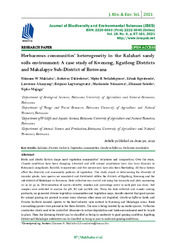| dc.contributor.author | Makhabu, Shimane W | |
| dc.contributor.author | Tshireletso, Koketso | |
| dc.contributor.author | Setlalekgomo, Mpho R | |
| dc.contributor.author | Kgosiesele, Ednah | |
| dc.contributor.author | Akanyang, Lawrence | |
| dc.contributor.author | Legwatagwata, Boipuso | |
| dc.contributor.author | Nsinamwa, Mackenzie | |
| dc.contributor.author | Seletlo, Zibanani | |
| dc.contributor.author | Majaga, Sipho | |
| dc.date.accessioned | 2022-07-06T09:23:35Z | |
| dc.date.available | 2022-07-06T09:23:35Z | |
| dc.date.issued | 2021-06-30 | |
| dc.identifier.citation | Shimane W Makhabu, Koketso Tshireletso, Mpho R Setlalekgomo, Ednah Kgosiesele, Lawrence Akanyang, Boipuso Legwatagwata, Mackenzie Nsinamwa, Zibanani Seletlo, Sipho Majaga. Herbaceous communities’ heterogeneity in the Kalahari sandy soils environment: A case study of Kweneng, Kgatleng Districts and Mahalapye Sub-District of Botswana. J. Bio. Env. Sci. 18(6), 87-101, June 2021. https://innspub.net/jbes/herbaceous-communities-heterogeneity-in-the-kalahari-sandy-soils-environment-a-case-study-of-kweneng-kgatleng-districts-and-mahalapye-sub-district-of-botswana/ | en_US |
| dc.identifier.issn | 2220-6663 | |
| dc.identifier.uri | https://innspub.net/jbes/herbaceous-communities-heterogeneity-in-the-kalahari-sandy-soils-environment-a-case-study-of-kweneng-kgatleng-districts-and-mahalapye-sub-district-of-botswana/ | |
| dc.identifier.uri | https://hdl.handle.net/13049/491 | |
| dc.description.abstract | Biotic and abiotic factors shape most vegetation communities’ structures and composition. Over the years, climatic conditions have been changing. Livestock and wild animal populations have also been dynamic in Botswana’s rangelands. Rainfall, temperatures and fire occurrences have also been fluctuating. All these factors affect the diversity and community patterns of vegetation. This study aimed at determining the diversity of vascular plants, how species are associated and distributed within the districts of Kgatleng, Kweneng and the sub-district of Mahalapye in Botswana. Data collection was carried out using line transects and plots measuring 20 m by 50 m. Determination of species identity, number and percentage cover in each plot was done. Soil samples were collected to analyse for pH, EC and particle size. From the data collected and remote sensing protocols, we generated diverse vegetation communities and vegetation maps. Results showed that good species for animal grazing are present in some areas whereas other areas are degraded. Cenchrus biflorus Roxb. and Pavetta harborii harmful species to the beef industry were noticed in Kweneng and Mahalapye areas. Bush encroaching species were present in the three districts. The area is being invaded by an exotic species, Verbesina encelioides which need to be controlled. Measures to reduce degradation and bush encroachment need to be put in place. Thus, the Kweneng district can be classified as being in moderate to good grazing condition. Kgatleng district and Mahalapye subdistrict can be classified as being in poor to moderate grazing conditions. | en_US |
| dc.language.iso | en | en_US |
| dc.publisher | International Network for Natural Sciences | en_US |
| dc.relation.ispartofseries | Journal of Biodiversity and Environmental Sciences;Vol. 18, No. 6, p. 87-101, 2021 | |
| dc.subject | Kalahari | en_US |
| dc.subject | Pavetta harborii | en_US |
| dc.subject | Vegetation communities | en_US |
| dc.subject | Cenchrus biflorus | en_US |
| dc.subject | Verbesina encelioides | en_US |
| dc.title | Herbaceous communities’ heterogeneity in the Kalahari sandy soils environment: A case study of Kweneng, Kgatleng Districts and Mahalapye Sub-District of Botswana | en_US |
| dc.type | Article | en_US |

